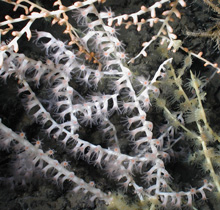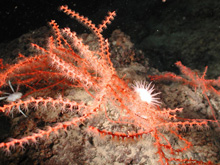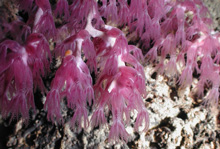
An image of the hard coral Madrepora oculata, with its pink and white skeleton, and other species of corals from the Coral Garden site. Large anemones and at least two species of crabs associated with the corals can also be seen in this image. Click image for larger view and image credit.
A red gorgonian from the Coral Garden. The eight tiny tentacles on each polyp place this group of corals in the sub-class Octocorallia. Note the anemone attached to the coral and a small galatheid crab in the background. Click image for larger view and image credit.
The Coral Gardens of Green Canyon 852
May 30, 2006
Erik Cordes
Harvard University
Cheryl Morrison
U.S. Geological Survey
26° 23.36 N
094° 30.87 W
We have spent most of our time on this cruise focused on the discovery and description of the communities associated with the seeps of the deep slope. One of the by-products of seepage is the formation of large carbonate rocks. Once the seepage of chemicals has begun to subside, these rocks are often colonized by corals. At one of our large, complex seep sites, Green Canyon 852, the initial camera reconnaissance survey from the research vessel (R/V) Gyre imaged a number of species of deep-sea corals. When we dove on this site, we located the corals that were imaged several months ago. We have also discovered that this coral area is about 30 m in diameter with large rock outcrops and pillars extensively colonized by many types of coral in an amazing array of colors. There are yellow, pink, and white scleractinians (stony corals), orange sea fans, white bamboo corals, and purple soft corals (all octocorals), plus bright red black corals (so named for their beautiful black skeleton underneath). We also caught several brief glimpses of a wide variety of other species.
Although several deep submergence vehicle (DSV) Alvin dives have visited this coral garden briefly during our cruise, the best characterization of the area was obtained during DSV Alvin Dive 4817, when we imaged a large area in a series of overlapping still photographs that have been assembled (or stitched together) into a photomosaic. The photomosaic gives us an idea of the types and abundance of corals, and where they are found (e.g., on tops versus the sides of rocks). It also gives us a better idea of the fauna that live among corals. Such associated fauna include a number of species of small crabs and shrimp, barnacles, and a flexible type of brittle star.

A white bamboo coral with extended polyps (with pink centers; also in the sub-class Octocorallia) from the Coral Garden. At the base of this bamboo coral, a yellow zoanthid has "moved in" where the bamboo polyps have died off. Note many more tentacles on the zoanthid (at lower right). Click image for larger view and image credit.
During our dives on this site, we were able to sample a number of the coral species. Each sample is precious and is studied to the fullest extent. Voucher specimens are collected and taken back to shore to confirm species identity, often requiring the attention of an expert in coral taxonomy. Any new species will be described in detail and kept in a museum for other researchers to examine and study. Other samples collected during this cruise will be used for DNA sequencing to determine their relationships to other corals and to members of the same species found in far away locations. We use this information to get a better understanding of how far coral larvae disperse. Samples of stony corals will be used to determine the age of the colonies. Additionally, long-lived bamboo and black corals may hold a record of climate change in the layers of their skeleton. The skeletons will be analyzed for changes in trace elements that are indicators of paleo-oceanographic events. As with most collections and data from this expedition, our work has only just begun.
Sign up for the Ocean Explorer E-mail Update List.






























